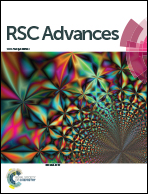Novel redox-responsive nanogels based on poly(ionic liquid)s for the triggered loading and release of cargos†
Abstract
The unique disulfide chemistry has been widely explored for novel and versatile delivery systems addressing both intracellular and extracellular barriers. In this study, novel redox-responsive nanogels were fabricated by radical copolymerization of ionic liquid (IL)-based monomers, 1,n-butanediyl-3,3′-bis-1-vinylimidazolium dibromide ([CnVIm]Br, n = 4, 6), and disulphide dimethacrylate (DSDMA) in selective solvents. The as-synthesized nanogels were characterized using scanning electron microscopy (SEM), Fourier transform infrared (FTIR) spectroscopy, thermogravimetric analyses (TG), dynamic laser scattering (DLS) and zeta (ζ)-potential measurements. The results demonstrated that the sizes of poly(ionic liquid) (PIL)-based nanogels can be tuned by the feed ratio of the monomers and DSDMA. Moreover, the redox-response performances of these nanogels were evaluated through the size variation in the presence of dithiothreitol (DTT) and benzoyl peroxide (BPO). The capability of PIL-based nanogels for controlled release was also investigated by using rhodamine B (RhB) as prototype model drug. It was found that DTT-triggered release of RhB could be achieved. Therefore, a redox-triggered loading and release matrix can be conveniently fabricated via PIL-based nanogels. And it can also be potentially used as a controlled carrier in biological medicine.


 Please wait while we load your content...
Please wait while we load your content...